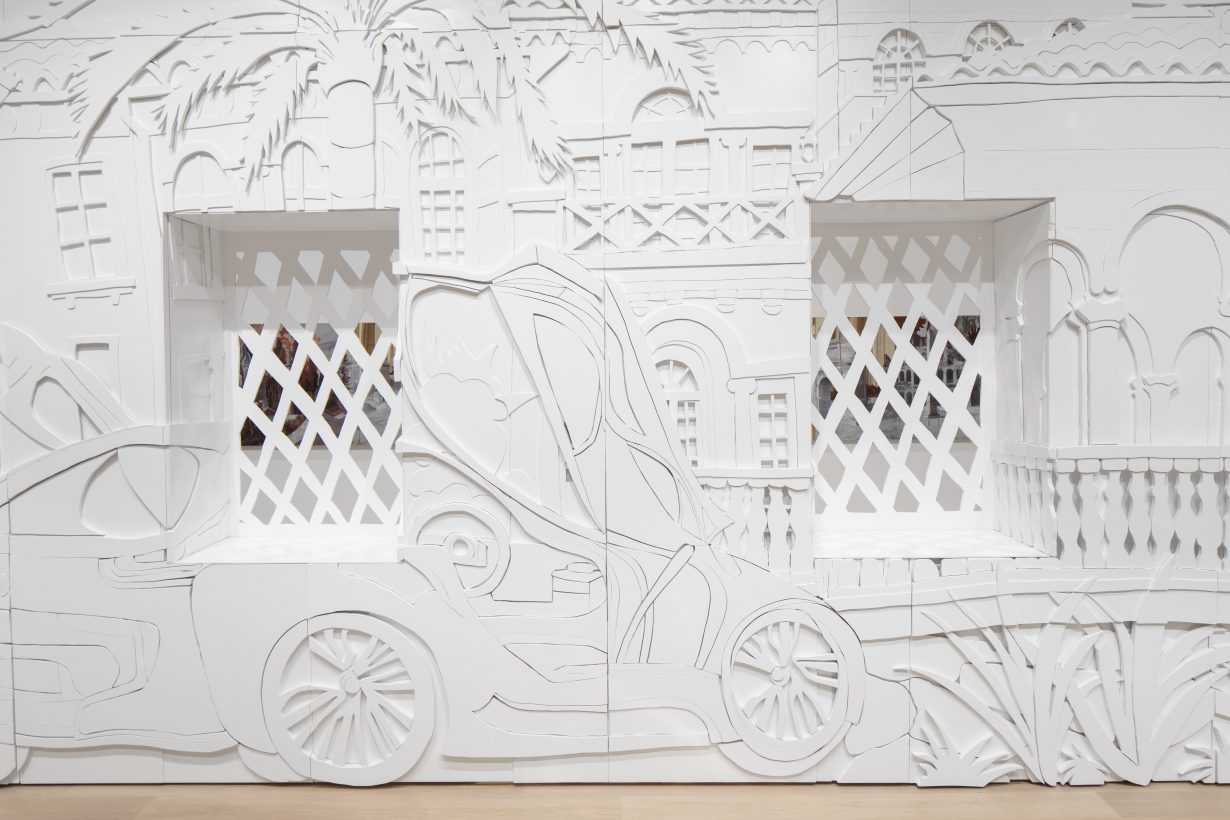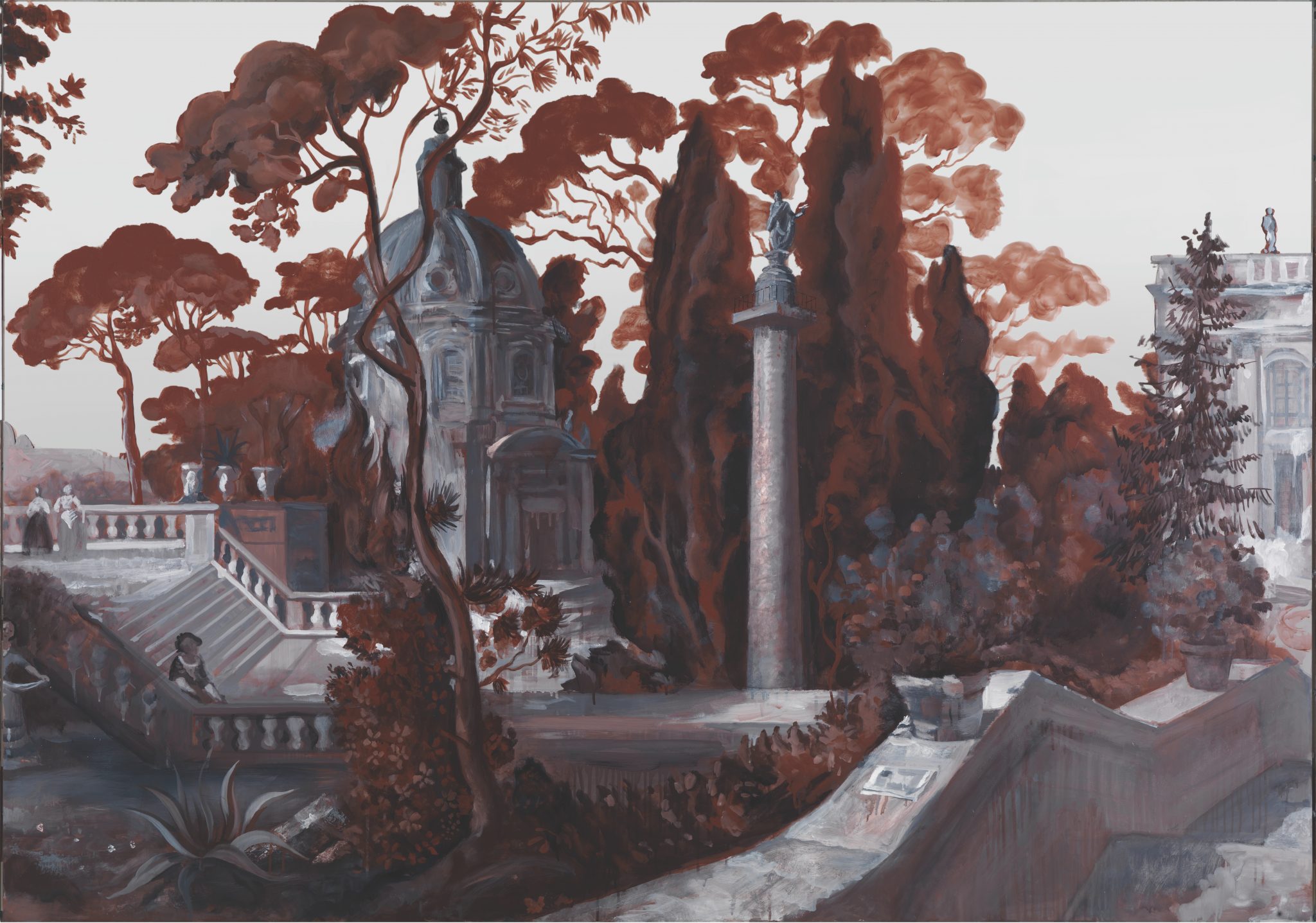Ahead of her show at SCAD Museum of Art, Savannah, the artist spoke to SCAD president and founder Paula Wallace about creativity, monotheistic religions and Disney World
In Façade, renowned sculptor and painter Rachel Feinstein lays bare the underpinnings of her constructed fantasy realms. On view at the SCAD Museum of Art in Savannah through 3 July 2023, Façade features painted panoramas, large-scale sculptures and 40-foot-long wall-reliefs from across Feinstein’s expansive career. During SCAD deFINE Art in February, the artist sat with SCAD President Paula Wallace to discuss her life and work.
What follows is condensed from a longer conversation for the ‘On Creativity with Paula Wallace’ series and podcast that will be available later this year.

Paula Wallace: Welcome to SCAD for deFINE ART, and thank you for joining me for ‘On Creativity’, Rachel. It’s really an honor to be exhibiting Façade at the SCAD Museum of Art. It’s just magnificent.
Rachel Feinstein: Thank you so much. I’m so happy to be here.
PW: Tell me a little bit about the title and how you curated this wonderful exhibition.
RF: When I came to Savannah to look at the SCAD Museum of Art and to see the city, I was taken with this idea of what’s underneath and what’s on top. Having grown up in Miami, I experienced Disney World many times because my dad would have his medical conventions there. I loved seeing this fake Cinderella Castle with the theme park workers walking in and out of the doors. I saw the fantasy, and then the reality.
With Savannah, it was very different. There was this incredible history with the Antebellum South and the preservation of the bricks inside the museum that were made by the enslaved peoples. There’s also this baroque quality with the moss and beautiful mansions with ironwork on the sides. This combination of extremes really appealed to me.
I’ve always been curious about the duality of stage sets – the presentation to the front yet something happening in the back. If you’re looking at a stage set, there are actors using the set but then there is the audience who is aware of it being a façade. Then there are the people backstage working to make the whole façade come to life. As an artist, I think I’m one of those people behind the scenes. In my work, I like having reality present with fantasy at the same time.
PW: Your exhibition Façade includes work as early as 2005 and demonstrates your dexterity with multiple mediums. How did you decide what you wanted to put in this particular show?
RF: It was hard. SCAD MOA assistant curator Brittany Richmond, who curated this exhibition, was very specific about keeping it all in the same colour sequence. I thought it was very important to have the red and the black and the white, the three colours of life in a lot of ways. We kept it cohesive by being very specific on the colour, tones and the hues.

PW: Your panorama of Rome is a captivating homage to the Eternal City and uses the vivid red popping against the declination of gray. Painting on a mirror must present a special challenge.
RF: It really does. I like the mirror because it’s not really a painting to me, it’s a sculpture. As I’m making the mirror painting, I see all the space around me, so it already becomes three-dimensional as I’m working on it. You see things in two separate categories as an artist – either you’re in your body or you’re outside of your body. It’s also linked to my interest in religion and philosophy.
If you look at traditional monotheistic religions, women were not allowed to rise to the highest rank because they were considered inside their body. They weren’t allowed to become the Pope or high levels of rabbis, because they were stuck to the earth. They were menstruating; they were pregnant; they were this; they were that: they were outside of their own control. The men were able to be outside of their body by basically elevating their souls away.
When you’re looking at a sculpture, you are inside your body. You feel it. My mirrors are very much about that: even though I’m working on a flat level, I am inside my body because I am seeing myself making it. I’m cutting the paint with big razors. It’s an experience that is not at all like painting. Painting, in my mind, is like taking a bubble bath and sculpture is like you’re out in the fields with a scythe. That’s why the mirror painting speaks to me, similar to working in copper and in wood.

PW: You gained inspiration from renaissance, baroque, rococo, and neoclassical sources. Art history seems to fuel you with passion, and actually is a core component of every SCAD degree program. All the students study art history in addition to whatever they’re majoring in. How does the past inspire you?
RF: In the beginning, I actually was pushed away from art history. I somehow thought that if you were given a lesson on how you put paint on a palette, then it would stop your own innate creativity. Coming from Miami where I had very little art historical background, I started to make art about the signpost on my street. That was actually what got me in the Greater New York show and was my big foray into the art world. Then I went to see the Black Forest in person and had this epiphany: Oh, my gosh, how can I not reference this? This isn’t Disney, this is the real thing. It changed the way I looked at things.
You have to listen to your own voice and intuition, but filter in those things from the past. You can learn so much, in every sense of the word, from people who came before you.
PW: How has your experience as a model and a set designer influenced your fine art practices?
RF: It was my first understanding of what it was like to be a creative person. My father was a doctor, my mom a nurse, and my sister’s a veterinarian down in Florida, so I didn’t have any experience with artists or creative people. I started modelling when I was around 14 and I did an Italian Vogue shoot with Bruce Weber. I remember talking to him about wanting to be an artist and he just said, “You can do it, you just have to get up to New York.”
I started to meet people through that world and to this day a lot of those people I met when I was 14 are still good friends. I still love working with fashion people because they have a very different perspective. Artists think about things being important after they die. In fashion they’re like, “We’ve got to do it right now. The time is right this second.” It’s not even tomorrow, it’s not even next year, it’s right this second.
PW: Speaking of fashion, your sculpture Puritan’s Delight was shown in SCAD’s Little Black Dress exhibition. In fact, André Leon Talley said of your work: “It represents to me collapsed elegance.” How does your work confront rules and conventions?
RF: I went to Schönbrunn, this palace in Vienna, and bought a little book of their carriages. I did a drawing of this carriage and I cut it up. I made it because I just liked the formal aspect of how it looked, but then afterwards I realized: “Ah, why did I put those crosses on there? It’s because of some type of death or accident.” It had a much more sinister side than I was aware of, and I hope that someone like André, someone very smart and very sensitive, picks up on those things. It is an unconscious act of making these things. It happens, hopefully, on its own.
